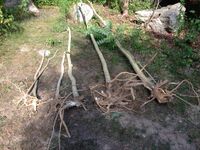Tree of Heaven: Difference between revisions
Watlington (talk | contribs) mNo edit summary |
Watlington (talk | contribs) m (Fixed links and harmonized style) |
||
| Line 1: | Line 1: | ||
'''Ailanthus altissima''' ([[wikipedia:Ailanthus_altissima|Wikipedia]], [https://plants.usda.gov/home/plantProfile?symbol=AIAL USDA], GoBotany, [https://www.invasiveplantatlas.org/subject.html?sub=3003 IPANE], [https://www.invasive.org/weedcd/pdfs/wow/tree-of-heaven.pdf USFS Weed of the Week!]) is a rapidly growing medium sized tree, up to 80ft. in height. It has large compound leaves, which resemble those of sumac but have a distinctive notch and an "eye" (gland) on each side at the base of the leaf. All parts of the tree smell like peanut butter. | '''Ailanthus altissima''' ([[wikipedia:Ailanthus_altissima|Wikipedia]], [https://plants.usda.gov/home/plantProfile?symbol=AIAL USDA], [https://gobotany.nativeplanttrust.org/species/ailanthus/altissima/ GoBotany], [https://www.invasiveplantatlas.org/subject.html?sub=3003 IPANE], [https://www.invasive.org/weedcd/pdfs/wow/tree-of-heaven.pdf USFS Weed of the Week!]) is a rapidly growing medium sized tree, up to 80ft. in height. It has large compound leaves, which resemble those of sumac but have a distinctive notch and an "eye" (gland) on each side at the base of the leaf. All parts of the tree smell like peanut butter. | ||
[[File:Ailanthus altissima 20200721a.jpg|thumb|Tree of Heaven]] | [[File:Ailanthus altissima 20200721a.jpg|thumb|Tree of Heaven]] | ||
[[File:Ailanthus altissima -close-up showing glands at leaflet bases.jpg|left|thumb|267x267px|Leaf base close-up]] | [[File:Ailanthus altissima -close-up showing glands at leaflet bases.jpg|left|thumb|267x267px|Leaf base close-up]] | ||
It spreads by seed and also aggressively by root rhizome. It produces toxins which prevent the establishment of other species. | It spreads by seed and also aggressively by root rhizome. It produces toxins which prevent the establishment of other species. | ||
== Removal == | |||
Larger trees should be [[Girding|girded.]] If cut, the root system will respond vigorously, by both sprouting at the stump and by sending up saplings from rhyzomes. After removal, expect an overwhelming surge in Tree of Heaven saplings in the area, and both the seed bank and the rhizome system react to the increased light. Repeated years of pulling will be needed to clear the area. | Larger trees should be [[Girding|girded.]] If cut, the root system will respond vigorously, by both sprouting at the stump and by sending up saplings from rhyzomes. After removal, expect an overwhelming surge in Tree of Heaven saplings in the area, and both the seed bank and the rhizome system react to the increased light. Repeated years of pulling will be needed to clear the area. | ||
[[File:Tree of Heaven Saplings.jpg|left|thumb|200x200px|Saplings and their root structures]] | [[File:Tree of Heaven Saplings.jpg|left|thumb|200x200px|Saplings and their root structures]] | ||
Smaller saplings should be pulled, with as much of the root structure as can be found. | Smaller saplings should be pulled, with as much of the root structure as can be found. | ||
== Common Mis-identifications == | |||
'''Smooth Sumac''' (''Rhus Glabra'', [[wikipedia:Rhus_glabra|Wikipedia]], [https://plants.usda.gov/home/plantProfile?symbol=rhgl USDA], [https://gobotany.nativeplanttrust.org/species/rhus/glabra/ GoBotany]) and '''Staghorn Sumac''' (''Rhus typhina'', [[wikipedia:Rhus_typhina|Wikipedia]], [https://plants.usda.gov/home/plantProfile?symbol=RHTY USDA], [https://gobotany.nativeplanttrust.org/species/rhus/hirta/ GoBotany]) have a compound leaf and juvenile growth form similar to Tree of Heaven. The difference is in the leaf detail (Sumac leaves are smooth at the base) and smell (Sumac does NOT smell like peanut butter). | '''Smooth Sumac''' (''Rhus Glabra'', [[wikipedia:Rhus_glabra|Wikipedia]], [https://plants.usda.gov/home/plantProfile?symbol=rhgl USDA], [https://gobotany.nativeplanttrust.org/species/rhus/glabra/ GoBotany]) and '''Staghorn Sumac''' (''Rhus typhina'', [[wikipedia:Rhus_typhina|Wikipedia]], [https://plants.usda.gov/home/plantProfile?symbol=RHTY USDA], [https://gobotany.nativeplanttrust.org/species/rhus/hirta/ GoBotany]) have a compound leaf and juvenile growth form similar to Tree of Heaven. The difference is in the leaf detail (Sumac leaves are smooth at the base) and smell (Sumac does NOT smell like peanut butter). | ||
[[File:Rhus vs Ailanthus altissima folia UGA-5451741.jpg|thumb|Leaves of Tree of Heaven (bottom) versus Sumac (top)]] | [[File:Rhus vs Ailanthus altissima folia UGA-5451741.jpg|thumb|Leaves of Tree of Heaven (bottom) versus Sumac (top)]] | ||
'''Black Walnut''' (''Juglans Nigra'', [[wikipedia:Juglans_nigra|Wikipedia]], [https://plants.usda.gov/home/plantProfile?symbol=juni USDA], [https://gobotany.nativeplanttrust.org/species/juglans/nigra/ GoBotany]) also has a similar compound leaf. The difference is that the Black Walnut leaves don't have the notch and "eye" at the base. | '''Black Walnut''' (''Juglans Nigra'', [[wikipedia:Juglans_nigra|Wikipedia]], [https://plants.usda.gov/home/plantProfile?symbol=juni USDA], [https://gobotany.nativeplanttrust.org/species/juglans/nigra/ GoBotany]) also has a similar compound leaf. The difference is that the Black Walnut leaves don't have the notch and "eye" at the base. | ||
Revision as of 15:57, 16 January 2024
Ailanthus altissima (Wikipedia, USDA, GoBotany, IPANE, USFS Weed of the Week!) is a rapidly growing medium sized tree, up to 80ft. in height. It has large compound leaves, which resemble those of sumac but have a distinctive notch and an "eye" (gland) on each side at the base of the leaf. All parts of the tree smell like peanut butter.


It spreads by seed and also aggressively by root rhizome. It produces toxins which prevent the establishment of other species.
Removal
Larger trees should be girded. If cut, the root system will respond vigorously, by both sprouting at the stump and by sending up saplings from rhyzomes. After removal, expect an overwhelming surge in Tree of Heaven saplings in the area, and both the seed bank and the rhizome system react to the increased light. Repeated years of pulling will be needed to clear the area.

Smaller saplings should be pulled, with as much of the root structure as can be found.
Common Mis-identifications
Smooth Sumac (Rhus Glabra, Wikipedia, USDA, GoBotany) and Staghorn Sumac (Rhus typhina, Wikipedia, USDA, GoBotany) have a compound leaf and juvenile growth form similar to Tree of Heaven. The difference is in the leaf detail (Sumac leaves are smooth at the base) and smell (Sumac does NOT smell like peanut butter).

Black Walnut (Juglans Nigra, Wikipedia, USDA, GoBotany) also has a similar compound leaf. The difference is that the Black Walnut leaves don't have the notch and "eye" at the base.